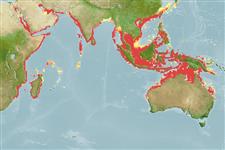Actinopterygii (ray-finned fishes) >
Perciformes (Perch-likes) >
Lutjanidae (Snappers) > Lutjaninae
Etymology: Pinjalo: A Malay word, pinialo, for a fish.
Environment / Climate / Range
Ecology
Marine; reef-associated; depth range 15 - 100 m (Ref. 90102). Tropical, preferred ?; 31°N - 16°S, 31°E - 149°E (Ref. 55)
Indo-West Pacific: Persian Gulf to the Gulf of Papua (Papua New Guinea), north to Taiwan.
Size / Weight / Age
Maturity: Lm ? range ? - ? cm
Max length : 80.0 cm TL male/unsexed; (Ref. 47613); common length : 30.0 cm TL male/unsexed; (Ref. 55)
Adults inhabit reefs and rocky bottoms (Ref. 30573). They are found in schools over shallow depths of a few meters in open ocean reefs. In most areas they are found in deep waters and are usually trawled to 100 m depth (Ref. 48635). They feed on benthic and planktonic invertebrates (Ref. 30573), and possibly small fishes. Marketed fresh or dried-salted.
Life cycle and mating behavior
Maturity | Reproduction | Spawning | Eggs | Fecundity | Larvae
Randall, J.E., G.R. Allen and W.D. Anderson Jr., 1987. Revision of the Indo-Pacific lutjanid genus Pinjalo, with description of a new species. Indo-Pac. Fish. (14):17 p. (Ref. 6177)
IUCN Red List Status (Ref. 115185)
CITES (Ref. 94142)
Not Evaluated
Threat to humans
Harmless
Human uses
Fisheries: minor commercial
More information
Common namesSynonymsMetabolismPredatorsEcotoxicologyReproductionMaturitySpawningFecundityEggsEgg development
ReferencesAquacultureAquaculture profileStrainsGeneticsAllele frequenciesHeritabilityDiseasesProcessingMass conversion
Tools
Special reports
Download XML
Internet sources
Estimates of some properties based on models
Phylogenetic diversity index (Ref.
82805): PD
50 = 0.7500 [Uniqueness, from 0.5 = low to 2.0 = high].
Bayesian length-weight: a=0.01479 (0.00715 - 0.03059), b=2.98 (2.81 - 3.15), in cm Total Length, based on LWR estimates for this (Sub)family-body shape (Ref.
93245).
Trophic Level (Ref.
69278): 3.5 ±0.41 se; Based on food items.
Resilience (Ref.
69278): Medium, minimum population doubling time 1.4 - 4.4 years (Preliminary K or Fecundity.).
Vulnerability (Ref.
59153): Moderate to high vulnerability (49 of 100) .
